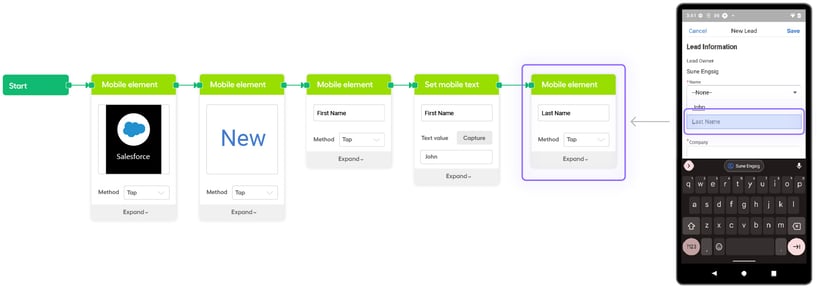Codeless Appium Test Automation: How It Works
If you’re a skilled tester, but don’t know how to code tests in Appium, running tests that keep up with your agile delivery pipeline will be a challenge. Codeless Appium automation is one way to bypass learning Appium from scratch.
In this brief post, you’ll learn how codeless automation in Appium works, as well as how it can benefit you and your business.
Skip ahead to:
Codeless Appium test automation
How Leapwork uses Appium under the hood
Codeless Appium test automation
Most enterprises use Appium for mobile app automation. It’s open-source and has small upfront startup costs. However, the time it takes to learn how to use Appium presents a major challenge to businesses that need a solution quickly.
Codeless automation, to many testers, presents a great opportunity. It can bring better productivity, an overall better user experience, and more time to work on edge cases.
If users don’t need to learn how to code Appium tests, every member of a quality assurance team can build and maintain tests.
So how does Leapwork use Appium while still providing a codeless approach to automation?
How Leapwork uses Appium under the hood
Leapwork uses Appium under the hood. Instead of building tests with code, Leapwork enables the people in your organization who really understand what a great user experience looks like to apply that knowledge to build, maintain, and scale test automation for any native mobile application.
No Appium coding, you only interact with native mobile tests using the unique, visual, no-code approach. It’s just like drawing on a whiteboard.
With native mobile automation blocks and a mobile smart recorder, it’s fast and easy to build tests on native mobile. Even gestures can be tested.
All you need is an Appium server in your environment. That way , you’re able to connect to the real devices that you need to test.

You can build flows quickly and easily, regardless of your background. No lagging, no coding. Easy to build automation, without the fuss.
You’ll be able to identify and resolve bugs faster and tackle your existing technical debt. That means less repetitive, boring testing, and more time to focus on the existing tasks that matter.
It also allows more people in your team to contribute to building and maintaining automation. Because of the visual approach, it’s quicker for your team to adopt the tool and get up and running.
For the business, this means happier and more efficient teams, faster time to market without introducing risk, and, ultimately, happier users.
Best of all, you can use the same visual approach and automate tests across platforms. From mobile to desktop, or mainframe.
You can learn more about Leapwork for native mobile apps in our extended guide to Mobile App Testing with Test Automation.

